The article presents the features of the process of pressing rapeseed seeds in order to obtain oil from them. For this purpose, the design of the PESH 30/4 press extruder was improved and the effect of temperature and seed weight on the process of obtaining oil by cold pressing was studied. Rapeseed of the Ratnik variety was selected for the experiment. 50, 100, 150 and 200 g of rapeseed seeds were poured into the press extruder. Pressing was carried out at a seed temperature of 20, 40, 60 and 80 ° C. It has been established that with this design of the press extruder and pressing factors, the oil yield can be about 70 % of its content in seeds.
Keywords: vegetable oil industry, process of pressing, temperature, rapeseed, screw, mass, oil output, oil loss, press-extruder, cold pressing.
В статье представлены особенности процесса прессования семян рапса с целью получения из них масла. Для этого была усовершенствована конструкция пресс-экструдера модели ПЭШ 30/4 и изучено влияние температуры и массы семян на процесс получения масла холодным отжимом. Для эксперимента были выбраны семена рапса сорта «ратник». В пресс-экструдер засыпали от 50, 100, 150 и 200 г семян рапса. Прессование проводилось при температуре семян 20, 40, 60 и 80°C. Установлено, что при данной конструкции пресс-экструдера и факторов прессования выход масла может составлять порядка 70 % от его содержания в семенах.
Ключевые слова: масложировая промышленность, процесс прессования, температура, рапс, шнек, масса, выход масла, потери масла, пресс-экструдер, холодное прессование.
Introduction
In industry, vegetable oils are extracted from the seeds of oilseeds by pressing (cold or hot) or extraction with gasoline. In addition, a combined method is used, including pressing followed by extraction of the oil remaining in the cake with a liquid solvent [1,2].
Cold pressing is one of the pressing methods without heating or at low temperature. After cold pressing, the oil temperature and the oil acidity coefficient are low. Cold-pressed oil usually does not require refining, and after precipitation and filtration, the finished oil is obtained [3, 4].
There is a special screw press, called a cold press, where the supply temperature of oilseeds is below 80 ° C, and it is not fried before the press.
Materials and methods.
For an experimental study of the oil extraction process, the seeds of spring rapeseed «Ratnik» were used. Rapeseed seeds are small, rounded, black in color (Fig.1). The weight of 1000 pieces of seeds is 3.4–4.7 g. The volume weight of seeds is about 636 kg / m 3 .
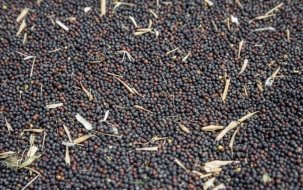
Fig.1. Rapeseed of ratnik variety
The aim of the study was to determine the effect of the temperature of rapeseed seeds and their mass in the press extruder on the process of cold pressing of oil.
The proposed improved design of the PESH 30/4 press extruder.

Fig.2. We offer advanced design press extruder PESH 30/4
1 — body, 2 — screw, 3 — sensor thermometer, 4 — heating element(spiral), 5, 11 — tip, 6 — channels, 7, 13 — bearing, 8 — manifold, 9 — thermometer, 10 — the case of the matrix, 12 — matrix
The principle of operation of the press:
The product enters the working chamber through the loading hole. The product passes through two main parts, moving along the screw.
In the 1st part, preliminary sequential processes of crushing and pressing the product are carried out and the product is heated to the required temperature, which allows the oil granules to decompose evenly in the product.
In the 2nd part, the process of secondary pressing of the product takes place. It allows the separation of oil granules and can be used to separate oil and cake (cake) and subsequent sequential processing or use.
The object of the study was threshed and cleaned from the remnants of the boxes of rapeseed. To extract oil from rapeseed seeds, a press extruder was made at the university, which allows pressing seeds in a periodic mode. It was filled with 50, 100, 150 and 200 g of rapeseed seeds. Pressing was carried out at a seed temperature of 20, 40, 60 and 80°C.
Research results and their discussion
The seeds of spring rapeseed «Ratnik» were used as the source material. The PESH-30/4 press extruder was selected as experimental equipment and has been improved. The quality of rapeseed oil and cake was evaluated according to GOST-methods for organoleptic and physico-chemical indicators.
Figure 3 shows the effect of temperature on the mass of the collected oil.
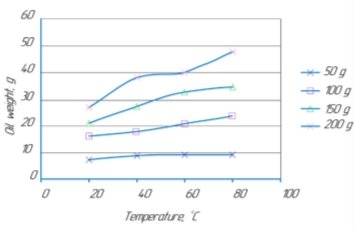
Fig. 3. The effect of temperature on the mass of the collected oil
As the data in Figure 3 show, an increase in seed temperature leads to an increase in the amount of oil produced, however, for a minimum loading weight of 50 g, the temperature practically does not affect the amount of oil. This is probably due to the fact that the force value per cubic cm of the briquette (specific force) provides almost complete oil extraction. Which is confirmed by Fig. 4.
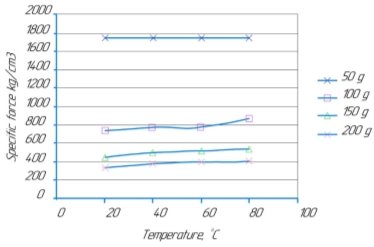
Fig. 4. The effect of temperature on the specific force during pressing
As the data in Figure 4 show, for a weight of 50 g, the specific force does not depend on temperature and is about 1750 kg / cm3. That is, for a 50 g suspension, you can reduce the pressure and the oil output should not change. For other attachments, the specific force increases slightly with increasing temperature.
It is also natural to reduce the specific force with an increase in the weight of the suspension, since the pressure value was the same.
Thus, it is necessary to set the minimum value of the specific force for each attachment, the growth of which in the future will not lead to an increase in oil yield.
Figure 5 shows the dependence of the oil mass on the weight of the suspension at different temperatures.
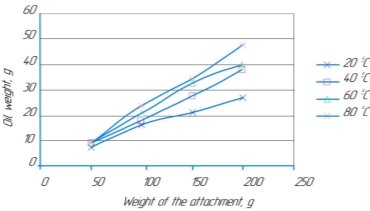
Fig. 5. The effect of the weight of the suspension on the mass of the collected oil
As the data in Figure 5 show, the dependence of the amount of oil on the weight of the suspension is almost linear. The effect of temperature on the amount of oil is higher the larger the hitch, that is, with a hitch of 50 g, all graphs converge at one point, and an increase in the weight of the hitch increases the difference in oil masses for the minimum and maximum temperatures. That is, the smaller the load, the less obvious the effect of temperature on the amount of oil collected.
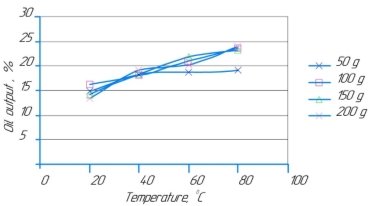
Fig. 6. Influence of temperature on oil output
Figure 6 shows the effect of temperature on the oil output, from which it can be seen that the oil output practically does not depend on the weight of the attachment and increases with increasing temperature, with the exception of a 50 g attachment for which the temperature practically does not affect the output. This once again confirms that the force created for the suspension of 50 g ensures maximum oil extraction. It would be logical to assume that for a weight of 50 g, due to the maximum value of the specific force, there should be a maximum oil yield, but this does not happen. So at 80 ° C for a 50 g suspension, the yield is about 19 %, and for all other attachments — about 24 %. This is due to oil losses that remain on the surfaces of the press extruder and screw. Which is confirmed by Fig. 7.
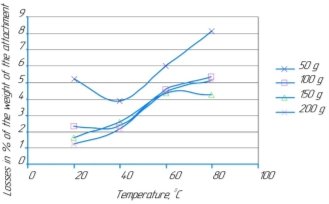
Fig. 7. The effect of temperature on oil loss
As the figure data show, with increasing temperature, losses increase. This is probably due to the lower viscosity of the oil when the temperature rises and, accordingly, its greater spreading over the surface of the press extruder and screw. For a weight of 50 g, the percentage of losses is maximum, which is most likely due to the peculiarities of pressing, since losses are the oil that was not collected from the extruder press, and the larger the weight, the smaller the percentage loss.
Conclusions
Thus, the features of the process of direct extraction of oil from rapeseed are investigated. It has been established that temperature is an effective way to increase oil yield. At 20°C, the yield is about 15 %, and at 80°C — about 24 %. The developed installation makes it possible to extract oil from rapeseed quite efficiently, since the oil consumption at 80 °C is about 69 % (24 *100/35 =68.57, where 35 % is the average oil content in rapeseed seeds). The screw press allows you to remove only 50 %. Losses due to oil spreading over the surfaces of the press extruder and screw can be reduced with constant oil extraction, since with several cycles of extraction there will always be a certain amount of oil on the surfaces, which will reduce losses.
References:
- Shcherbakov, V. G. Osnovnye processy proizvodstva rastitel'nyh masel [Technology of vegetable oil production] / V. G. Shcherbakov. — M.: Kolos, — Moscow: 1992 — p. 100–101
- Beloborodov, V. V. Osnovnye processy proizvodstva rastitel'nyh masel [The main processes of vegetable oil production] / V. V. Beloborodov. — M.: food industry, — Moscow: 1966 — p. 203–206
- Akaeva, T. K. Osnovy himii i tekhnologiya polucheniya i pererabotki masel. Chast' 1. Tekhnologiya polucheniya rastitel'nogo masla [Fundamentals of chemistry and technology of obtaining and processing oils. Part 1. Technology of vegetable oil production] / T. K. Akaeva, S. N. Petrova. — Ivanovo: 2007 — p.36–37
- Goncharov, G. I. Tekhnologii i oborudovanie dlya proizvodstva pishchevyh zhirov [Technologies and equipment for the production of edible fats] / U. I. Goncharov, A. A. Bush. — Kiev: 2011 — p. 42–44







